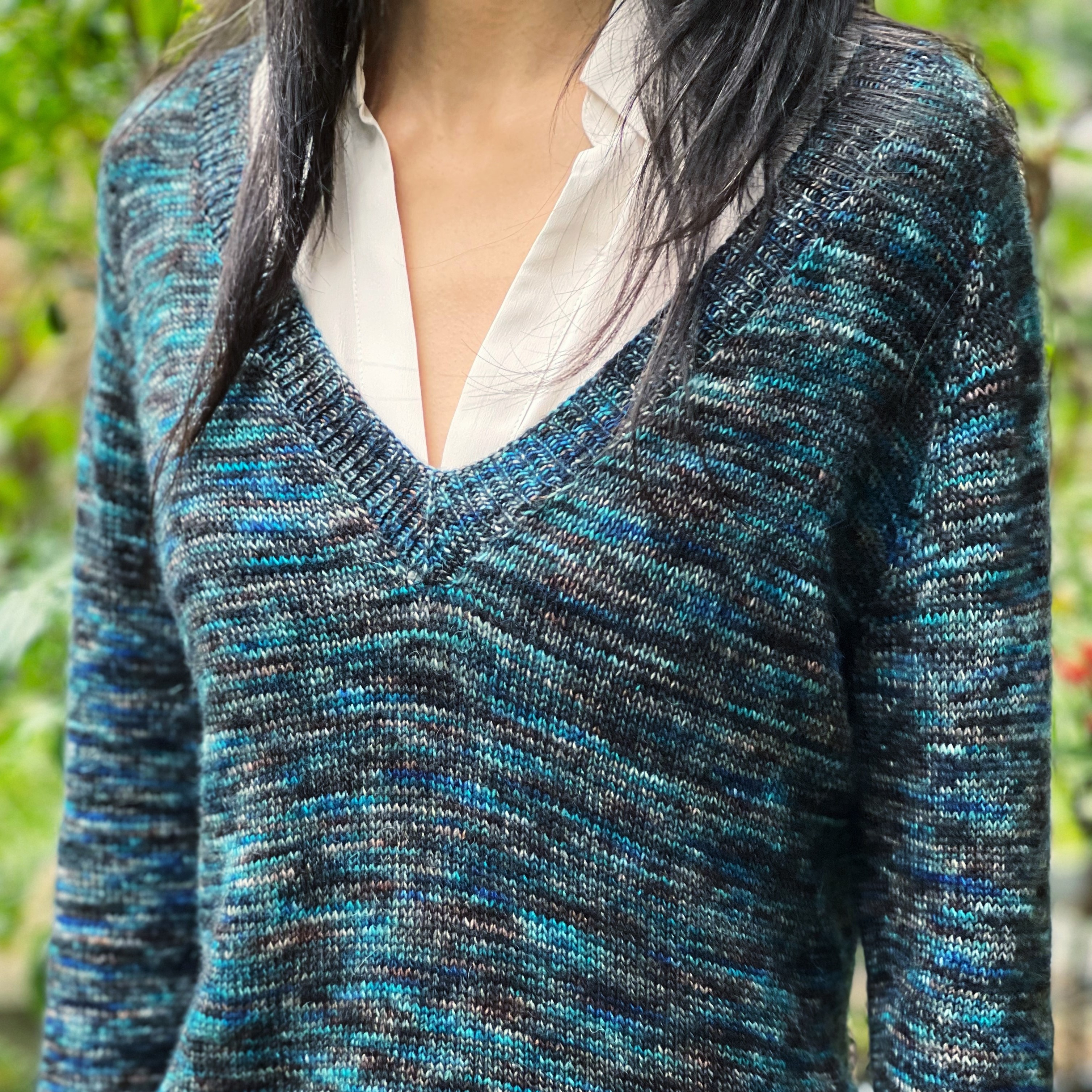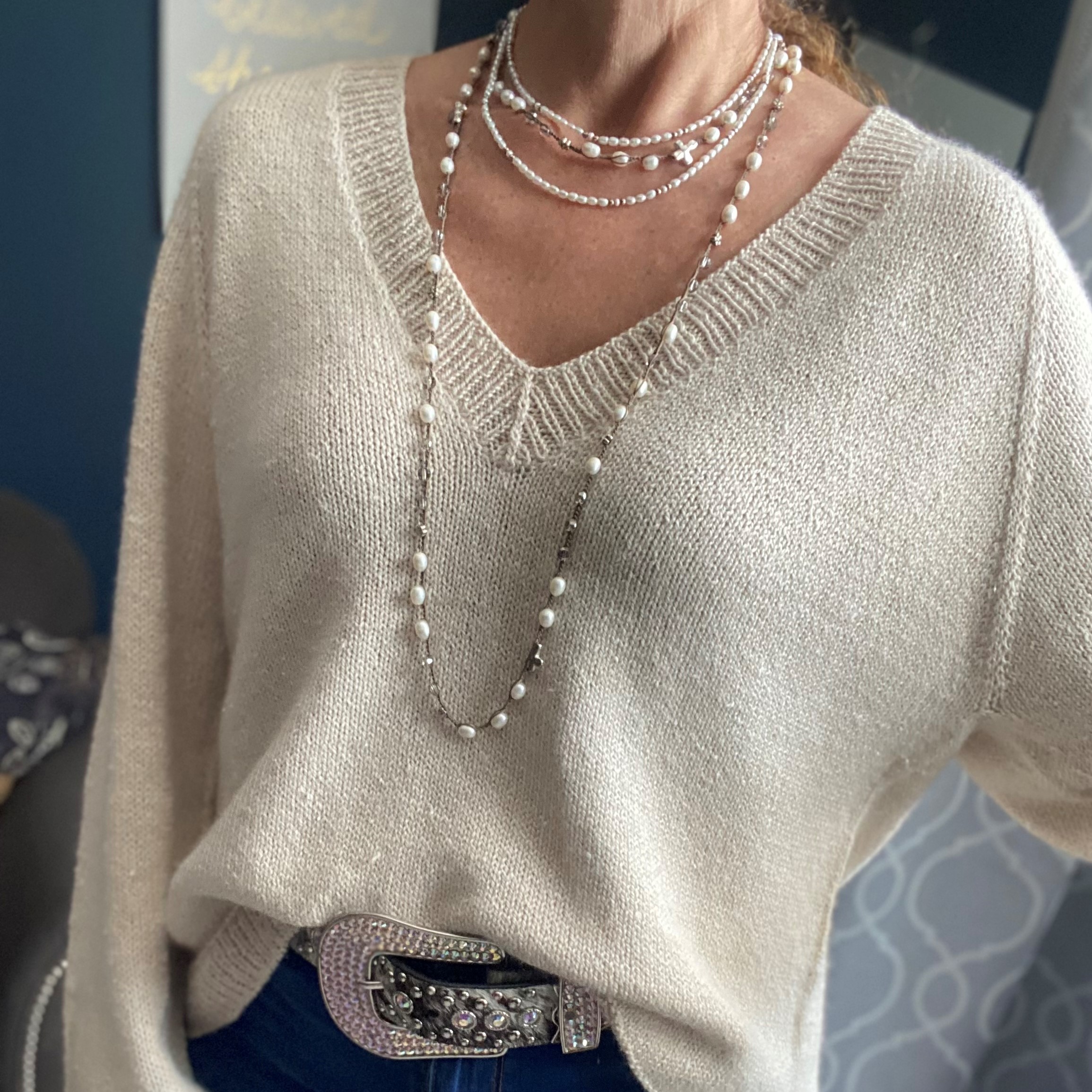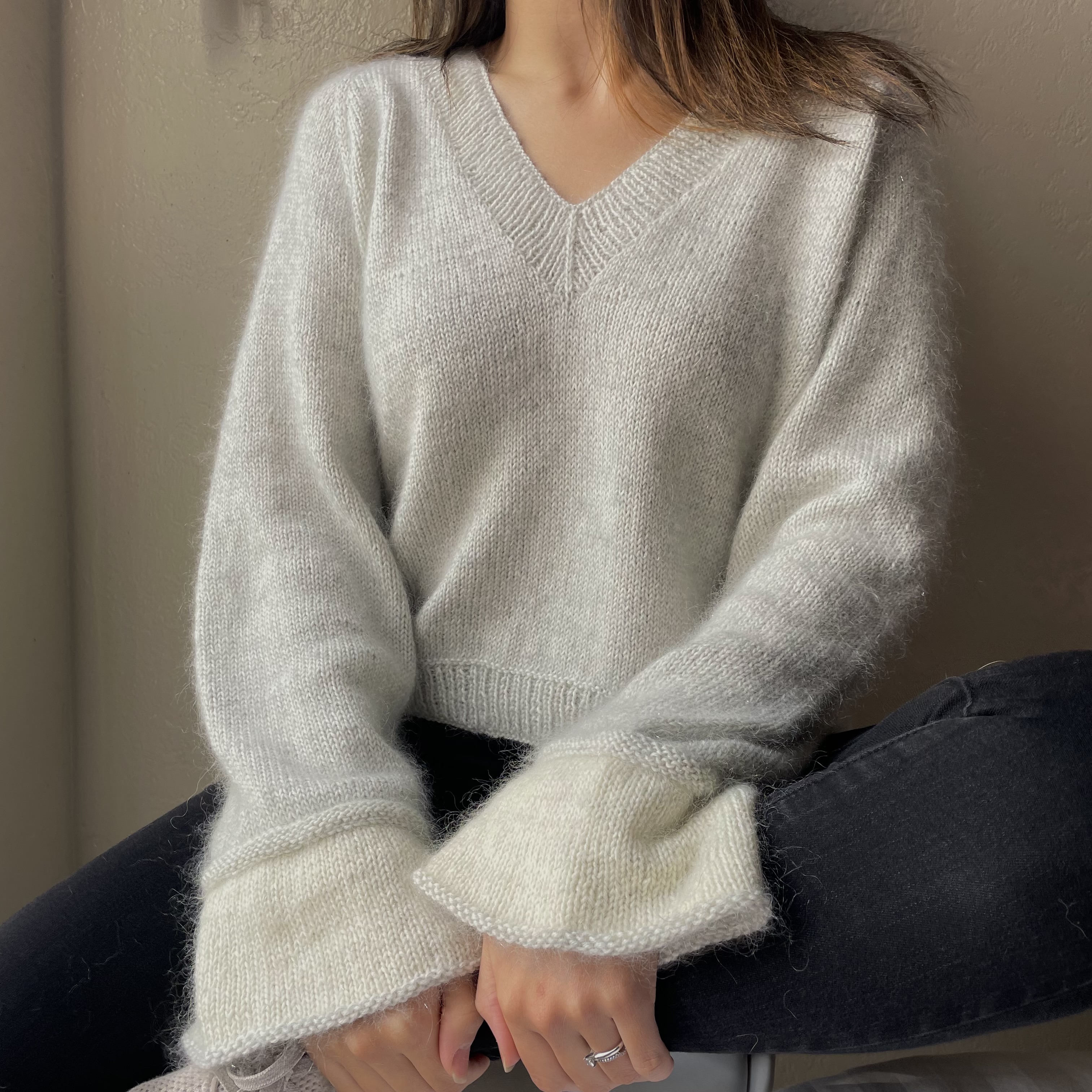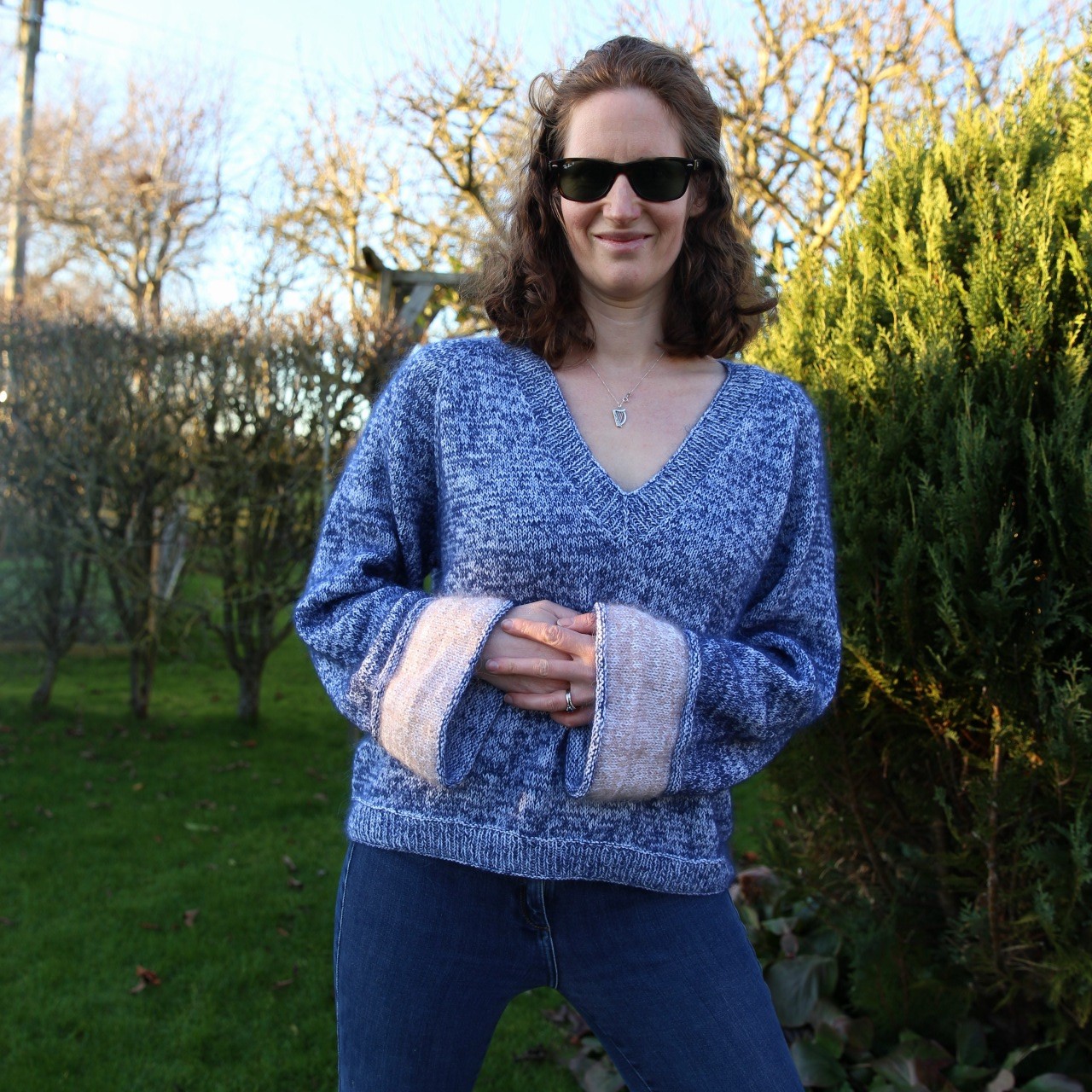Hello, good day, happy 2022! Today I’m sharing my first knitting pattern release of the year, the Thin Air Sweater. Named for obvious airy floaty reasons.
Scroll down for details and to purchase the Thin Air Sweater knitting pattern
This sweater began in the long hot days of last summer, during the bizarre time when we had 25 degree weather for a fortnight here in the UK. In other words, rather a long time ago! And then my yarn launch came along and all the patterns and admin that went with it, and then I had other chunky projects to finish before Winter… and I spent ages working on the hem only for it to look awful and require re-knitting… and here we are. Only 6 months later! To be honest it’s a great all year round item anyway so the delay doesn’t bother me too much. I’ll be wearing this on milder Winter days and breezy Spring days anyway – just not on tomato sauce eating days.
the cashmere yarn
Cardiff Cashmere kindly provided the cashmere and silk yarns I used for the Thin Air sweater. As you can imagine, it’s ridiculously soft and is an absolute dream to wear and knit with!. I used Cardiff Cashmere Classic in shade Candido for the body, and Set Ball in shade Cabane for the cuffs, both provided by Itaca Yarns. (Ad / yarn support)
the raglan construction
In theory, raglans are one of the simplest sweater constructions. Basic increases, how complicated can it be? HA. They’re simple until you factor in the different neck to bust ratios across a 28-62″ bust size range, and until you throw in a v-neck to complicate things. A v-neck that needs to remain more or less the same across the size range, whilst the rates of raglan increase change. It’s always the ‘simplest’ ones that turn out to be a headache! A lengthy Excel spreadsheet later and we have a pattern that is actually very straightforward to knit – all of the techniques involved are accessible to a new-ish knitter.
the v-neck & gauge
I love a high neck sweater but felt it was time for a change! And because I have a particular dislike for middling necklines that are neither here nor there, I decided the v-neck was going to be fairly low. Pre-neckband it looked alarmingly low, but I know to trust the process with these things. Never underestimate the power of the neckband!
That said, the neckline depth was one of the most discussed points in the test knit group chat. As you can see there’s quite a variety in neck depths among the testers, several of whom followed the exact same size. Takeaway point being that gauge and yarn choice make a huge difference, row gauge in particular. When swatching, most knitters (me included), prioritise the stitch gauge (in this case 23 sts to 4″ / 10cm) with the assumption that rows can be easily adjusted. However, for a low v-neck, the row gauge is critical. A couple of rows out will make all the difference. I’d suggest prioritising meeting the row gauge (32 rows to 4″ / 10cm) as this will have most impact on the overall fit of the sweater. The Thin Air Sweater is designed to be worn with 8-10 inches of positive ease, so a couple of inches either way won’t make a huge difference to a sweater that’s already so roomy. A couple of inches deeper v-neck will though, so keep that in mind!
test knitter roundup
Thank you so much to all my wonderful testers who brought this pattern to life! Test knit chats are always a lovely supportive group and this one was no different – thanks for helping each other out and being such a great bunch of people. And thanks for the colour and yarn inspiration too – I love seeing my patterns in palettes I would never have thought of!
Thin Air Sweater knitting pattern details
YARN (Yarn A): DK weight yarn, approx. 1041 (1176; 1266; 1350; 1457) 1510; 1628; 1753; 1861 metres / 1135 (1282; 1380; 1472; 1588) 1646; 1775; 1911; 2028 yards.
Sample shown in Cardiff Cashmere Classic, (100% cashmere, 112 metres per 25g ball) in shade Candido. If using this yarn, you will need 10 (11; 12; 13; 14) 14; 15; 16; 17 balls.
Yarn B: DK weight yarn, approx. 102 (106; 110; 112; 116) 118; 120; 124; 126metres / 111 (116; 120; 122; 126) 129; 131; 135; 137 yards.
Sample shown in Cardiff Cashmere Set (100% silk, 88m per 25g ball) in shade Cabane. If using this yarn, you will need 2 balls.
GAUGE: 23 sts and 32 rows to 4 inches / 10 cm in stocking stitch, blocked. Suggested needle size 3.75mm.
NEEDLES: 3.5mm and 3.75mm circular needles for working body and neckband
3.75mm needles of your preferred length for working small circumferences in the round (ie. DPNs, magic loop)
Scrap yarn
Tapestry needle
SIZING: 1 (2; 3; 4; 5) 6; 7; 8; 9 detailed below, designed to be worn with between 8 – 10 inches / 20 – 25 cm positive ease. Sample shown is a size 2 worn on a 34†bust with around 8†/ 20 cm positive ease.
Due to the significant amount of positive ease factored into this design, I would strongly advise against sizing up as the neckline will be too wide. If you are between sizes, size down. If you have a large bust relative to your shoulders, I would also recommend sizing down.
To fit bust: 28-30 (32-34; 36-38; 40-42; 44-46) (48-50; 52-54; 56-58; 60-62) inches / 71-76 (81-86; 91-97; 102-107; 112-117) (122-127; 132-137; 142-147; 152-157) cm.
Finished bust: 39.5 (44.5; 48; 52; 56.5) 59; 63.5; 68; 72.5 inches / 101 (113; 122; 133; 143) 150; 161; 173; 184 cm.
Construction: the Thin Air sweater is worked seamlessly from the top down with a raglan construction. Stitches are cast on at the neck, short rows are worked to shape the shoulders, and the yoke is worked back and forth in rows. After completing the yoke, sleeve stitches are set aside and some sizes work further increases at the front neck.
Yarn choices: yarn used in the sample is technically a DK weight, but is definitely on the finer side of DK. Some sport weight yarns may knit up to a similar gauge, and some DK yarns may be too heavy. I would recommend swatching to find a yarn / needle combination that creates a slightly airy fabric at this gauge. The Thin Air sweater uses 2 yarns of similar thickness but very different textures, in this case a soft cashmere for the body and a shiny silk for the turnback cuffs. A similar effect could be created by using wool for the body and bamboo for the cuffs, or other fibres with contrasting properties.
I LOVE seeing people knit my patterns and make them their own – if you could tag @lilykatemakes and #ThinAirSweater on Instagram that would be great!
The Thin Air sweater knitting pattern is also available via Ravelry and Etsy.
Lily Kate x
YouTube | Instagram | Email me | Facebook group | Newsletter







































No Comments